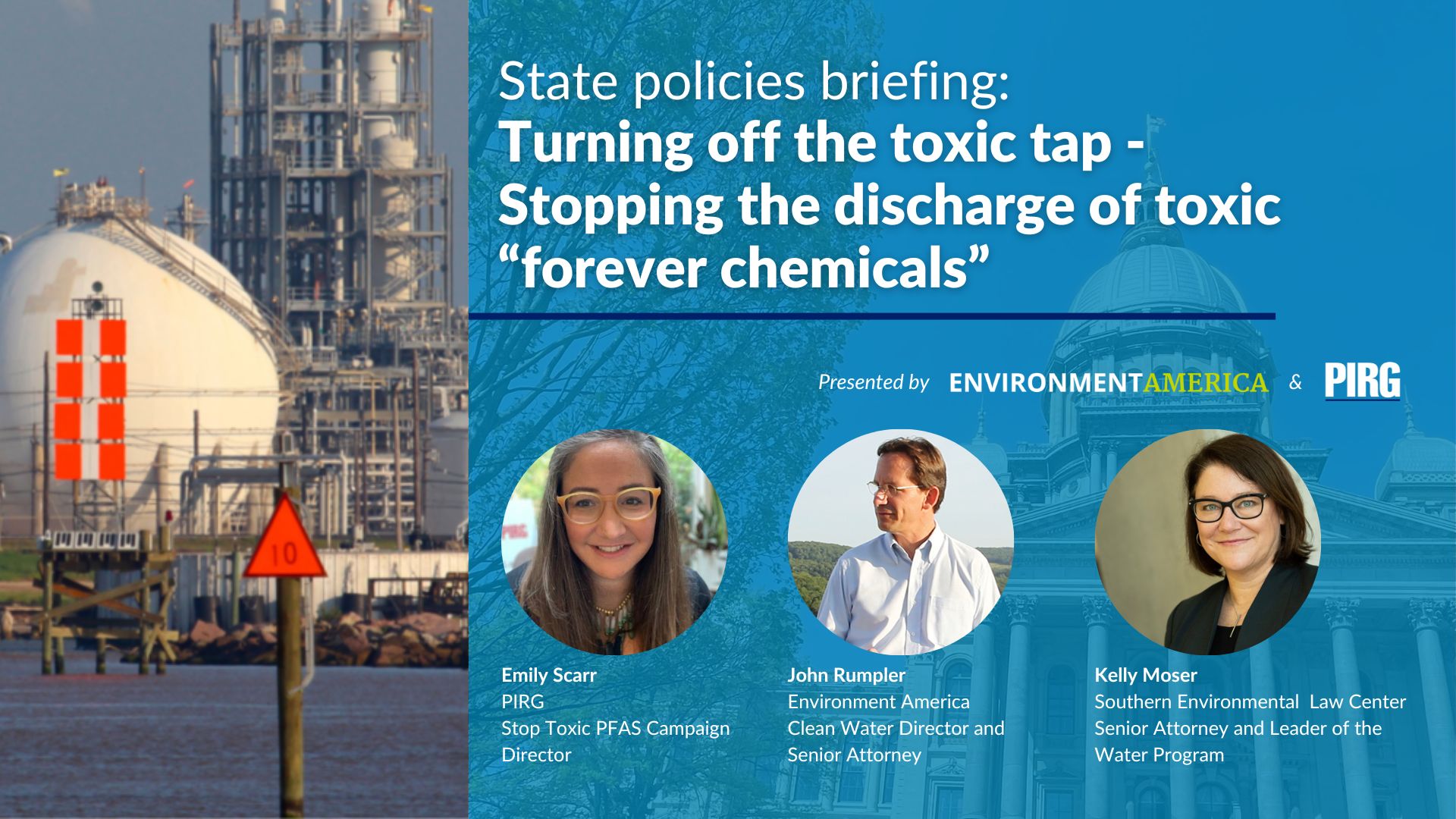
Protecting Maryland Water from PFAS Pollution
The Maryland General Assembly is considering a bill to restrict PFAS discharge from large industries into our waterways and to wastewater treatment plants.
The Maryland Department of Environment has found toxic PFAS “forever chemicals” in some of Maryland’s drinking water. According to the U.S. Environmental Protection Agency, there is no safe level of some PFAS in drinking water and exposure to PFAS chemicals, even in small amounts over time, has been linked to serious health effects including cancer, thyroid disruption and reduced vaccine response.
Accordingly, the EPA has proposed a maximum contamination level of 4 ppt for several PFAS in drinking water, which is a big step forward from the previous advisory of 70 ppt.
We’re calling on the Maryland General Assembly and the Moore Administration to protect our families by establishing strict limits for PFAS discharge from large industries into our waterways and to wastewater treatment plants.
PFAS in Maryland
The Maryland Department of Environment (MDE) has found PFAS in the majority of water treatment plants they have tested. According to Maryland’s PFAS Action Plan 14% of Maryland industries that responded to a survey reported having PFAS sources on-site.
In some cases, manufacturers and users of these chemicals are dishcarging them directly into our rivers, lakes and streams. Other companies might be “indirectly” discharging PFAS by sending it to treatment plants. This toxic pollution threatens not only our drinking water but also fish and wildlife.
There is known contamination in and around more than a dozen military sites and in seafood in Maryland.
In 2022, the Maryland General Assembly passed the George “Walter” Taylor Act, with broad bi-partisan support to restrict the use of PFAS in food packaging, rugs and carpets, and firefighting foam in Maryland.

The “forever chemicals”
PFAS have been given the nickname “forever chemicals” because they don’t break down in our bodies or in the environment. So the more they get used, the more they build up and the bigger the risk they pose to our health. This is particularly concerning for our kids who could be exposed to these chemicals for decades to come.
According to a 2020 report from leading PFAS experts PFAS should be regulated as a class in order to protect health:
“Managing PFAS one-by-one is neither feasible nor cost-efficient. More comprehensive solutions are needed, given that traditional approaches have failed to control widespread exposures to PFAS and resulted in inadequate public health protection. We suggest class-based options to more comprehensively and efficiently reduce PFAS exposure.”

The Threat of “Forever Chemicals”
Protecting our communities
The best way to address PFAS contamination and all that comes with it, is to prevent it in the first place. Until we can fully phase out the use of PFAS, we need to prevent industries from releasing these chemicals into our waterways.
The EPA has made clear that states can restrict PFAS discharges under the Clean Water Act. Moreover, existing pollution control technology can capture roughly 99 percent of PFAS in wastewater.
Maryland should limit PFAS discharge into our waterways, sewage treatment plants and stormwater. Now is the time for the state to act.

The Protecting State Waters From PFAS Pollution Act (SB956/HB1153)
State Sen. Katie Fry Hester and Delegate Sara Love have introduded legislation to protect Marylanders by strictly limiting PFAS discharge from large industries into our waterways and to wastewater treatment plants.
This important legislation will help ensure polluting industries bear responsibility for preventing PFAS contamination in our waterways and drinking water, preventing Maryland taxpayers and families from paying the costs with our health and pocketbooks.
The bill sets a discharge limit of 4 parts per trillion.
- Companies that use PFAS must use modern technology to filter out PFAS from wastewater.
- PFAS contaminants captured by industry must be safely stored or disposed of and cannot be put in incinerators, municipal landfills, or applied to land.
- Industries that violate the law will be held accountable.
Topics
Authors
Emily Scarr
State Director, Maryland PIRG; Director, Stop Toxic PFAS Campaign, PIRG
Emily directs strategy, organizational development, research, communications and legislative advocacy for Maryland PIRG. Emily has helped win small donor public financing in Baltimore City, Baltimore County, Howard County, Montgomery County, and Prince George's County. She has played a key role in establishing new state laws to to protect public health by restricting the use of antibiotics on Maryland farms, require testing for lead in school drinking water and restrict the use of toxic flame retardant and PFAS chemicals. Emily also serves on the Executive Committees of the Maryland Fair Elections Coalition and the Maryland Campaign to Keep Antibiotics Working. Emily lives in Baltimore City with her husband, kids, and dog.
John Rumpler
Clean Water Director and Senior Attorney, Environment America
John directs Environment America's efforts to protect our rivers, lakes, streams and drinking water. John’s areas of expertise include lead and other toxic threats to drinking water, factory farms and agribusiness pollution, algal blooms, fracking and the federal Clean Water Act. He previously worked as a staff attorney for Alternatives for Community & Environment and Tobacco Control Resource Center. John lives in Brookline, Mass., with his family, where he enjoys cooking, running, playing tennis, chess and building sandcastles on the beach.
Find Out More

2024 Maryland Legislative Session: Wins and Losses

PIRG’s warmest wishes for a safe and happy new year

Trouble in the water? MD issues new fish consumption advisories for PFAS



